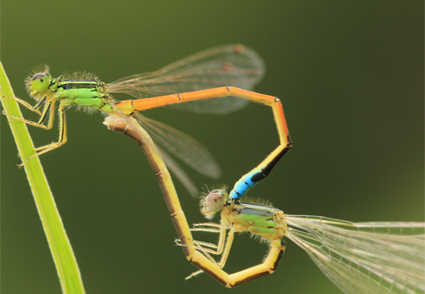Abstract
Ischnura praematura sp. nov. (Holotype ♂, China, Yunnan, Lijiang, 26º31´03.54”N, 100º13’38.89”E, 2396 m, 04 xii 2015, I. Sanmartín-Villar & H. Zhang leg.) is morphologically described, illustrated and compared with close species of the genus. Ischnura praematura can be mainly distinguished from its congeners I. aurora, I. rubilio and I. asiatica by its abdominal and thoracic morphology and colouration. The posterior lobe of the prothorax is elevated in I. praematura and the mesostigmal plates possess dorsal triangular protuberances. Ischnura praematura shows pointed paraprocts, internalised wide cerci and lacks a dorsal tuberculum in the tenth abdominal segment. The blue abdominal colouration is present in the last three segments (incomplete for segment eight and ten in some individuals). No female polychromatism was detected and all females observed possessed different colouration than male (gynochrome). Morphological distinctiveness of the species is supported by genetic analyses, which show that I. praematura forms a well-supported, monophyletic clade, with I. asiatica, I. ezoin and I. pumilio as the most closely related species. In the field, mature females show strong reluctance to mate, and males were observed mating with newly emerged females.
References
Cordero-Rivera, A. (1987) Estructura de población en Ischnura (Zygop. Coenagrionidae). Boletín de la Asociación española de Entomología, 11, 269–286.
Cordero-Rivera, A. (2017) Behavioral diversity (ethodiversity): a neglected level in the study of biodiversity. Frontiers in Ecology and Evolution, 5, 1–7. https://doi.org/10.3389/fevo.2017.00007
Cordero-Rivera, A. & Córdoba-Aguilar, A. (2010) Selective forces propelling genitalic evolution in Odonata. In: Córdoba-Aguilar, A. & Leonard, J. (Eds), The evolution of primary sexual characters in animals. Oxford University Press, Oxford, pp. 332–352.
Debecker, S., Sanmartín-Villar, I., de Guinea-Luengo, M., Cordero-Rivera, A., Stoks, R. (2016) Integrating the pace-of-life syndrome across species, sexes and individuals: covariation of life history and personality under pesticide exposure. Journal of Animal Ecology, 85, 1–13. https://doi.org/10.1111/1365-2656.12499
Dijkstra, K.-D.B. & Lewington, R. (2006) Field guide to the dragonflies of Britain and Europe. Bloomsbury, 318 pp.
Futahashi, R., Okude, G., Sugimura, M. & Ugai, S. (2018) Interspecific hybrids in Japanese Odonata. Tombo, 60, 1–49.
Garrison, R.W., von Ellenrieder, N. & Louton, J.A. (2010) Damselfly genera of the New World. Johns Hopkins University Press, Baltimore, 490 pp.
Huelsenbeck, J.P. & Ronquist, F. (2001) MRBAYES: Bayesian inference of phylogenetic trees. Bioinformatics, 17, 754–755. https://doi.org/10.1093/bioinformatics/17.8.754
Katoh, K., Misawa, K., Kuma, K.I. & Miyata, T. (2002) MAFFT: A novel method for rapid multiple sequence alignment based on fast Fourier transform. Nucleic Acids Research, 30, 3059–3066. https://doi.org/10.1093/nar/gkf436
Katoh, K. & Standley, D.M. (2013) MAFFT multiple sequence alignment software version 7: Improvements in performance and usability. Molecular Biology and Evolution, 30, 772–780. https://doi.org/10.1093/molbev/mst010
Kumar, S., Stecher, G., Li, M., Knyaz, C. & Tamura, K. (2018) MEGA X: Molecular evolutionary genetics analysis across computing platforms. Molecular Biology and Evolution, 35, 1547–1549. https://doi.org/10.1093/molbev/msy096
Lorenzo-Carballa, M.O., Hadrys, H., Cordero-Rivera, A. & Andrés, J.A. (2012) Population genetic structure of sexual and parthenogenetic damselflies inferred from mitochondrial and nuclear markers. Heredity, 108, 386–95. https://doi.org/10.1038/hdy.2011.84
Miller, M.N. & Fincke, O.M. (1999) Cues for mate recognition and the effect of prior experience on mater recognition in Enallagma damselflies. Journal of Insect Behavior, 12, 801–814.
Robertson, H.M. & Tennessen, K.J. (1984) Precopulatory genital contact in some Zygoptera. Odonatologica, 13, 591–595.
Ronquist, F. & Huelsenbeck, J.P. (2003) MrBayes 3: Bayesian phylogenetic inference under mixed models. Bioinformatics, 19, 1572–1574. https://doi.org/10.1093/bioinformatics/btg180
Rowe, R.J. (1978) Ischnura aurora (Brauer), a dragonfly with unusual mating behaviour (Zygoptera: Coenagrionidae). Odonatologica, 7, 375–383.
Rowe, R.J. (2010) Ischnura aurora (Brauer 1865) (Zygoptera: Coenagrionidae), an Australo-Pacific species. New Zealand Journal of Zoology, 37, 189–192. https://doi.org/10.1080/03014223.2010.488789
Sánchez-Guillén, R.A., Ceccarelli, S., Villalobos, F., Neupane, S., Rivas-Torres, A., Sanmartín-Villar, I., Wellenreuther, M., Bybee, S., Velasquez-Vélez, M.I., Realpe, E., Chávez-Ríos, J.R., Dumont, H.J. & Cordero-Rivera, A. (2020) The evolutionary history of colour polymorphism in Ischnura damselflies. Odonatologica, 49, 333–370. https://doi.org/10.5281/zenodo.4268559
Sánchez-Guillén, R.A., Van Gossum, H. & Cordero-Rivera, A. (2005) Hybridization and the inheritance of female colour polymorphism in two ischnurid damselflies (Odonata: Coenagrionidae). Biological Journal of the Linnean Society, 85, 471–481. https://doi.org/10.1111/j.1095-8312.2005.00506.x
Sanmartín-Villar, I. & Cordero-Rivera, A. (2016) The inheritance of female colour polymorphism in Ischnura genei (Zygoptera: Coenagrionidae), with observations on melanism under laboratory conditions. PeerJ, 4, 1–19. https://doi.org/10.7717/peerj.2380
Sanmartín-Villar, I., Zhang, H. & Cordero-Rivera, A. (2016) Colour polymorphism and ontogenetic colour changes in Ischnura rufostigma (Odonata: Coenagrionidae). Odonatologica, 45, 77–86. https://doi.org/10.5281/zenodo.50850
Srivastava, B.K. & Babu, B.S. (1984) Some observations on oviposition of Ischnura aurora (Brauer) in Indian biotope (Zygoptera: Coenagrionidae). Fraseria, 7, 24.
Stamatakis, A. (2014) RAxML version 8: A tool for phylogenetic analysis and post-analysis of large phylogenies. Bioinformatics, 30, 1312–1313. https://doi.org/10.1093/bioinformatics/btu033
Zhang, H.M. (2019) Dragonflies and damselflies of China. Chongqing University Press, Chongqing, 1460 pp.


